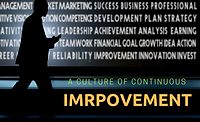The Top 5 Myths of Quality Improvement




After combing through a successful company’s financial history and seeing gains in both sales and profitability year after year, it can often be difficult to suggest there is still opportunity for improvement. Even more challenging can be convincing the personnel who produced those lucrative results that improvement is possible. Despite this, successful businesses must continually strive to improve, often in ways they don’t know exist. This stimulates invention, increases barriers of entry into the marketplace, and builds value at all levels.
If you search the web on the topic of quality improvement, you will find hundreds of theories and models that have been developed by a multitude of authorities on the subject. With every credible theory comes an equally impressive list of critics. Using the third part of Joseph Juran’s Trilogy on managing for quality, I will attempt to debunk what I feel are the top five myths of quality improvement as they relate to the restoration industry.
Myth #1: Don’t fix it if it isn’t broke
The term quality improvement suggests corrective action for failure. This is misleading, especially considering that Juran’s definition of quality focuses on a freedom from deficiencies. In service-based industries like restoration, quality improvement is typically measured by the number of complaints or callbacks received. When things are running smoothly, these are minimal, and work is plentiful. Consequently, businesses fail to look for opportunities to improve and are lulled into complacency while consistently meeting originally planned levels of quality.
The reality is that successful companies continually monitor and measure their business processes and look for opportunities for improvement. This should be especially true in methods of service delivery. Developing innovative ways for producing services faster, at a lower cost, and with less waste will be the hallmark of growing companies in the next era of restoration contractors.
Myth #2: Quality improvement is limited to manufacturing environments
It is true that the leading authorities dealing with quality improvement developed the majority of their concepts from manufacturing scenarios. This is because process inputs and controls are extremely stable and have little variation. Manufacturing is also the easiest to track and measure. Total Quality Management (TQM), Six Sigma, Plan Do Check Act (PDCA), and many others rely heavily on methods of measurement that can prove to be challenging for service industries.
Time is the great differentiator in being able to utilize these highly effective models as the basis for improvement in service delivery. Juran suggests that companies must establish specific projects dedicated to quality improvement. To be effective, those projects must focus on the activities within the process that are time sensitive. Being able to increase the efficiency with which companies communicate, schedule, dispatch, obtain approvals, produce documentation, and so on will greatly improve your company’s value to the client and, ultimately, your profit margins at the bottom line.
Myth #3: We are too busy
One of my all-time favorite quotes from Stephen Covey is actually a question he asked a participant during one of his time management lectures. As she was trying to pile rocks labeled with life’s top priorities into a bucket full of pebbles, she removed one of the rocks labeled “sharpen the saw” in favor of another. He turned to her and asked: “Have you ever been too busy driving to get gas?” I think that sums it up.
Successful companies make quality improvement an active part of business. They plan for it, budget for it, and assign dedicated teams to improve the specific business activities identified. The effective leaders of these organizations don’t just expect suggestions and recommendations in this realm. They demand results. They enable creativity and encourage levels of innovation that transform the way they do business.
Myth #4: You have to be the best
In early October of 2004, I remember parking along Grant Avenue in the Millvale area of Pittsburgh just days after the remnants of Hurricane Ike dumped over 17 inches of rain across the region. The street was lined with restoration companies’ vehicles, all working to clean up the aftermath from the flooding that left thousands of folks with uninsured losses. As I was gathering my things to go to the job site, I was summoned by a gentleman looking at two of my competitors’ vehicles across the road. Both vehicles were lettered with the tagline: “The leader in restoration and damage repair.” The individual looked at me and asked, “Are there any followers in this business because I can’t afford the leaders?” Well said.
Quality improvement initiatives should focus on bringing value to the customer. Value is measured by the customers’ willingness to pay for the services you provide. Companies that understand this match their levels of quality with the needs and expectations of the person paying the bill.
Unfortunately, the restoration industry has an overemphasis on maximizing the benefits allowed under the terms of an insurance policy. If companies were to redirect the time and effort spent trying to outsmart insurance adjusters and direct it toward developing ways to reduce the cost of service delivery, they would immediately catapult to the top in their local market share.
Myth #5: It won’t work anyway
Restorers are some of the most creative individuals on the planet when it comes to technical aptitude. They can figure out how to clean, deodorize, and repair materials that most other rational thinking folks would abandon. When it comes to business, however, the mindset is different: “This is the way we have always done it, and there is no other way.” Perhaps it is pride or maybe just a comfort level with the way their businesses operate. Regardless of the reason, we continually observe a regular resistance to change in at least small increments from most companies in the industry.
With that said, we must realize that not all quality improvement initiatives are going to be successful. This is why it is important to provide the solutions and establish controls for maintaining the improvement desired. This involves testing process improvements in small scale implementations, identifying the barriers that hinder improvement, and eliminating them systematically. These “pilot” projects should not be treated as trial and error. Rather, they should be seen as opportunities to test the limits of the process and see where the breaking points are.
Since the beginning of time, people have looked at their surroundings and asked themselves: “How can we make this better?” The invention of the wheel, cotton gin, assembly line, telephone, internet, and more all started because someone asked themselves that question. This is the very essence of quality improvement at the most rudimentary level. In the restoration industry, computerized estimating, advanced moisture detection methods, high efficiency dehumidifiers, photo inventory tools, and much more were all developed because someone was dedicated to asking that same basic question. Quality improvement is not some sophisticated, scientific, or mathematical conundrum. It’s a simple question: How can we make this better?
Looking for a reprint of this article?
From high-res PDFs to custom plaques, order your copy today!









